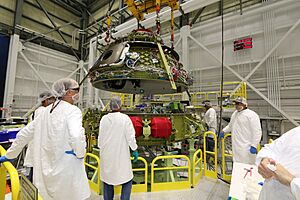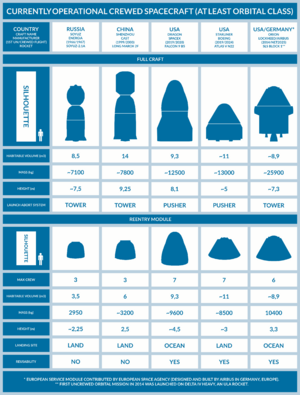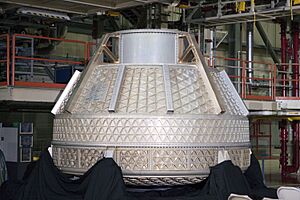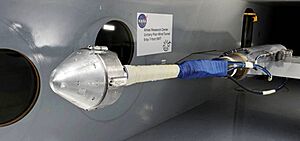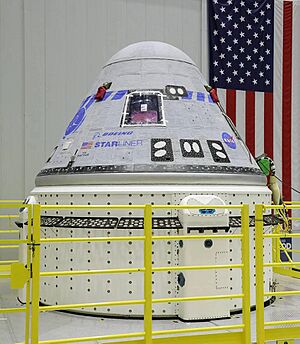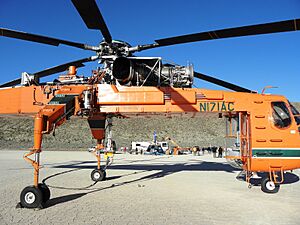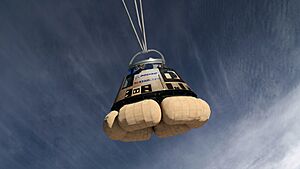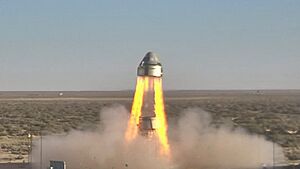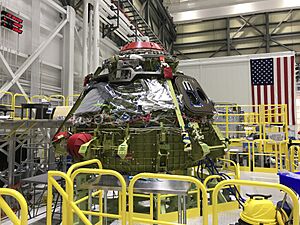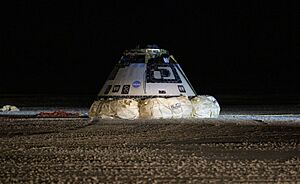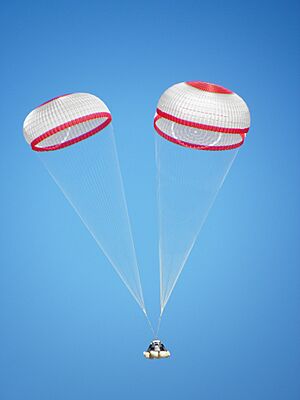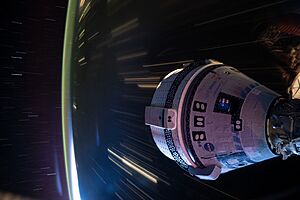Boeing Starliner facts for kids
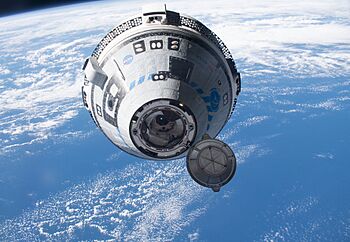
Boeing Starliner Spacecraft 2 approaching the ISS in May 2022, during Orbital Flight Test 2
|
|
| Manufacturer | Boeing Defense, Space & Security |
|---|---|
| Country of origin | United States |
| Operator | Boeing Defense, Space & Security |
| Applications | ISS crew transport |
| Specifications | |
| Spacecraft type | Capsule |
| Design life |
|
| Payload capacity | To ISS: 4 crew and 100 kg (220 lb) cargo |
| Crew capacity | Up to 7 |
| Volume | 11 m3 (390 cu ft) |
| Regime | Low Earth orbit |
| Dimensions | |
| Length | 5.03 m (16.5 ft) (Capsule and SM) |
| Diameter | 4.56 m (15 ft) |
| Production | |
| Status | Active |
| Built | 3 |
| Operational | 2 |
| Retired | 1 |
| Maiden launch | Uncrewed: December 20, 2019 Crewed: June 5, 2024 |
| Configuration | |
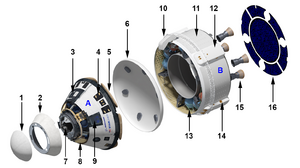 Exploded view of the Starliner A: Crew capsule, B: Service module 1: Nosecone, 2: Parachute compartment cover, 3: Crew access hatch, 4: RCS thrusters for re-entry, 5: Airbags, 6: Heat shield, 7: NASA Docking System, 8: Parachutes, 9: Window, 10: Umbilical, 11: Radiators, 12: "Doghouse" with RCS and OMAC thrusters, 13: Propellant tanks, 14: Roll control thruster, 15: RS-88 engines for launch escape, 16: Solar panels |
|
The Boeing Starliner (also called CST-100) is a special spacecraft. It is made to carry astronauts to and from the International Space Station (ISS). It can also go to other places in low Earth orbit.
Boeing developed the Starliner for NASA's Commercial Crew Program. The spacecraft has two main parts. One part is a capsule that can be used again. The other part is a service module that is used only once.
The Starliner is a bit bigger than the SpaceX Crew Dragon. It can carry up to seven people. However, NASA plans to fly no more than four astronauts at a time. It can stay connected to the ISS for up to seven months. The Starliner launches into space on an Atlas V N22 rocket. This rocket takes off from Cape Canaveral Space Launch Complex 41 in Florida.
NASA gave Boeing a contract in 2014 to build and operate the Starliner. The spacecraft was first planned to be ready in 2017. But it faced many delays because of problems with its design and management.
The first test flight without a crew happened in December 2019. It was not a full success. This led to a second uncrewed test flight in May 2022. The first crewed test flight launched in June 2024. During this flight, some of the Starliner's small engines (thrusters) had problems. NASA decided it was too risky for the astronauts to return to Earth on the Starliner. The spacecraft landed without a crew in September 2024.
Why the Starliner Was Built
After the Space Shuttle program ended, NASA wanted new ways to send astronauts to space. Instead of owning and operating all spacecraft, NASA tried a new idea. Companies would own and operate the spacecraft. NASA would then buy rides for its astronauts. This new way was meant to encourage companies to create new and better spacecraft.
Boeing has a long history of building spacecraft. They helped build parts of the Saturn V rockets and the Lunar Roving Vehicles. Boeing has also been a main partner for the US Orbital Segment of the ISS since 1993. Because of their experience, Boeing was a strong choice for these new space contracts.
In 2010, Boeing showed off its new spacecraft, the CST-100. This was part of NASA's Commercial Crew Program. Boeing received money from NASA to help develop the Starliner. They hoped the Starliner would be ready to fly by 2015.
NASA also leased a building at Kennedy Space Center to Boeing. This building was used to build and test the Starliner. Over the next few years, NASA continued to give Boeing money for the Starliner's development.
In 2014, NASA chose both Boeing and SpaceX to build crewed spacecraft. Boeing received a contract to finish and certify the Starliner. SpaceX received a contract for its Crew Dragon spacecraft. Both companies needed to complete several tests. These tests included an emergency escape test, an uncrewed test flight, and a crewed test flight. After these tests, they would fly missions to the ISS.
How the Starliner Works
The name CST-100 means "Crew Space Transportation." The "100" refers to the Kármán line. This is an unofficial boundary of space about 100 kilometers (62 miles) above Earth. The Starliner's design uses ideas from Boeing's past projects. These include the Apollo missions, the Space Shuttle, and the ISS.
The Starliner has two main parts: a reusable capsule and a service module that is used once. The capsule can carry up to seven people. For NASA missions, it carries four astronauts and some cargo. The Starliner capsule can be used up to ten times. Each flight uses a new service module. This module helps the spacecraft move and provides power. The Starliner also has wireless internet and uses tablets for the crew.
The Starliner uses the NASA Docking System to connect to the ISS. Boeing added a special cover to the Starliner's nose. This cover protects the docking port when the spacecraft re-enters Earth's atmosphere.
The capsule has a special heat shield to protect it during re-entry. Solar cells on the service module provide electricity for the spacecraft. There is also a structure called an aeroskirt. This helps the rocket fly smoothly during launch.
The Starliner has 64 engines, called thrusters. These thrusters help the spacecraft move and turn in space. Some thrusters are used for small movements. Others are used for bigger changes in orbit. Four powerful engines are used for emergency escapes during launch.
The Starliner is designed to land on land, not in the ocean. This is a first for a crewed capsule launched from the United States. After re-entering the atmosphere, three parachutes open. They slow the capsule down to about 4 miles per hour (6.4 km/h). Before landing, six airbags inflate to cushion the impact. There are several landing sites in the Western United States. This allows the service module to fall into the Pacific Ocean.
Testing the Starliner
Boeing started testing parts of the Starliner in 2011. Full spacecraft tests began in 2019.
Emergency Escape and Landing Tests
In 2011, Boeing tested the airbag system that cushions the Starliner's landing. These airbags inflate just before the capsule touches the ground. In 2012, Boeing dropped a Starliner model from a helicopter. This test successfully checked the spacecraft's three main landing parachutes.
In June 2018, there was an incident during an engine test. A problem with the fuel system caused a large amount of toxic fuel to leak. This created a fireball. Boeing later said they were fixing 80 issues found after this incident.
A pad abort test happened on November 4, 2019. This test showed if the capsule could escape safely from a rocket if something went wrong on the launchpad. The capsule launched away from the pad. One of its three parachutes did not open, but the landing was still safe. Boeing said the test was a success.
First Uncrewed Orbital Flight Test
The first uncrewed Orbital Flight Test (OFT) launched on December 20, 2019. It carried a test dummy named "Rosie the Rocketeer." The mission faced serious problems and was called a partial failure.
After launch, the spacecraft's clock was 11 hours off. This caused the thrusters to fire for too long. The Starliner used too much fuel and could not reach the ISS. Another software error was found that could have caused a crash between the service module and the capsule.
The spacecraft landed safely two days later in New Mexico. After its landing, NASA astronaut Sunita Williams named the spacecraft Calypso. This name honors the research ship used by ocean explorer Jacques Cousteau.
After the mission, Boeing admitted they had not tested the entire mission from start to finish. They had only tested smaller parts. This contributed to the software errors. NASA was also criticized for not pushing Boeing to do a full end-to-end test.
Second Uncrewed Orbital Flight Test
Because the first test flight had problems, Boeing decided to fly a second uncrewed mission. This mission, called OFT-2, launched on May 19, 2022. It also carried Rosie the Rocketeer.
During the flight, some thrusters had problems. However, the spacecraft was able to use other thrusters to make up for it. It successfully docked with the International Space Station.
On May 25, 2022, the capsule returned to Earth and landed safely. During re-entry, one of the navigation systems briefly lost contact with GPS satellites. NASA said this was expected during re-entry.
Crewed Flight Test
The Starliner's crewed flight test was meant to be its final test before regular NASA missions. It launched on June 5, 2024, with two astronauts: commander Barry Wilmore and pilot Sunita Williams. The plan was to dock with the ISS for about a week.
As the Starliner approached the ISS, several of its thrusters began to fail. Commander Wilmore had to take manual control. NASA allowed the docking to continue even with the problems. Eventually, five thrusters failed, making it very hard to control the spacecraft. The astronauts later said the situation was "very precarious."
Mission Control decided to try resetting the thrusters. Two thrusters came back online, but then another failed. A second reset brought all but one thruster back. This allowed the Starliner to dock with the ISS. Five helium leaks were also found in the service module.
Despite public statements, the astronauts privately worried about returning on the Starliner. By late August 2024, NASA decided it was too risky for the crew to return on the spacecraft. The Starliner returned to Earth without the crew on September 7, 2024. It landed safely in New Mexico.
A later investigation found that the thruster problems were caused by a seal that warped from heat. NASA is now reviewing all the mission data. This will help them decide what steps are needed to make the Starliner ready for regular flights. NASA has said that Boeing is committed to continuing the Starliner program.
Commercial Use of Starliner
Under the Commercial Crew Program, Boeing owns and operates the Starliner capsules. This means Boeing can offer flights to other customers, like space tourists. However, these flights cannot get in the way of NASA missions. So far, Boeing has not sold any private commercial flights.
Boeing, Blue Origin, and Sierra Nevada Corporation announced plans for a commercial space station called Orbital Reef. The Starliner could be used to visit this future space station.
Launch Rocket
The Starliner was designed to work with several different rockets. These include the Atlas V, Delta IV, Falcon 9, and Vulcan Centaur.
For its test flights and future missions, the Starliner flies on the Atlas V rocket. However, the company that makes the Atlas V stopped building them in 2024. The remaining rockets have been set aside for customers, including the six needed for Starliner flights.
The Starliner's future after these flights is uncertain. The Delta IV rocket is no longer used. The Falcon 9 is owned by SpaceX, a competitor. The Vulcan Centaur rocket has not yet been approved for human spaceflight. Boeing would have to pay for those tests.
Atlas V Configuration
For Starliner launches, the Atlas V rocket uses a special setup called N22. This means it does not have a nose cone (payload fairing). It has two solid rocket boosters (SRBs) and a Centaur second stage with two engines.
The Starliner is the only crewed spacecraft that flies on the Atlas V. The Atlas V uses older, human-rated solid rocket boosters for Starliner missions. These are different from the newer boosters used for cargo flights.
The Centaur second stage with two engines was brought back for Starliner missions. Two engines allow the rocket to fly a smoother path. This reduces the forces on the astronauts. It also makes sure the capsule can escape safely at any time if there is a problem.
How Starliner Launches
After launch, the rocket goes through several steps. It drops its solid rocket boosters and the first stage. Then, the Centaur second stage fires. It releases the Starliner spacecraft about 15 minutes after liftoff.
The Starliner is released on a path that is just below the speed needed to stay in orbit. This is called a suborbital trajectory. It is similar to how the Space Shuttle launched. This path ensures that if the spacecraft cannot reach orbit, it will re-enter the atmosphere safely. After separating from the rocket, the Starliner's own thrusters fire. This boosts the spacecraft into its final orbit to travel to the International Space Station.
Starliner Spacecraft
Boeing planned to have three Starliner capsules. Each capsule could be reused up to ten times. However, in 2020, Boeing decided to use only two capsules for all planned missions.
| S/N | Name | Type | Status | Flights | Flight time | Total flight time | Notes | Cat. |
|---|---|---|---|---|---|---|---|---|
| S1 | None | Prototype | Retired | 1 | 1m 19s (PAT) | 1m 19s | This prototype was used only for the pad abort test. | |
| S2 | TBA | Crew | Active | 1 | 5d 23h 54m (OFT-2) | 5d 23h 54m | Completed the OFT-2 flight. | |
| S3 | Calypso | Crew | Active | 2 |
|
95d 14h 31m | Named after Jacques Cousteau's ship RV Calypso. It was the first Starliner to orbit during OFT and the first to carry a crew during CFT. |
List of Starliner Flights
This list includes flights that have already happened or are planned. Dates are in UTC.
| Mission and Patch | Capsule | Launch date | Landing date | What Happened | Crew | Outcome |
|---|---|---|---|---|---|---|
| Pad Abort Test (patch) |
S1 | November 4, 2019 | This test simulated an emergency escape from a failing rocket. The Starliner's engines lifted the capsule from the pad. Only two of three parachutes opened, but the test was still called a success. | N/A | Success | |
| Orbital Flight Test (patch) |
S3.1 Calypso |
December 19, 2019 | December 22, 2019 | This was the first uncrewed orbital flight test. The spacecraft orbited Earth but could not reach the ISS. It landed successfully. | N/A | Partial failure |
| Orbital Flight Test 2 (patch) |
S2.1 | May 19, 2022 | May 25, 2022 | This was the second uncrewed orbital flight test. Some thrusters had problems, but the spacecraft successfully docked with the ISS. | N/A | Success |
| Crew Flight Test (patch) |
S3.2 Calypso |
June 5, 2024 | September 7, 2024 | This was a crewed flight test to the ISS. The spacecraft landed without the crew because of problems with its thrusters. | Partial failure | |
| Starliner-1 | S2.2 | TBD | TBD | TBA | Planned | |
| Starliner-2 | TBD | TBD | TBD | TBA | Planned | |
| Starliner-3 | TBD | TBD | TBD | TBA | Planned | |
NASA has ordered three Starliner flights once the capsule is fully approved for use. They have the option to buy up to six flights in total. However, it is not clear if all these missions will happen before the ISS is retired in 2030.
Partners in Technology
- Aerojet Rocketdyne: Made the thrusters and emergency escape rockets.
- Airborne Systems: Made the parachutes.
- Bigelow Aerospace: Helped with parts of the crew capsule.
- Collins Aerospace: Made the life support systems.
- David Clark Company: Made the spacesuits.
- ILC Dover: Made the airbags.
- Samsung: Provided mobile communication technology.
- Spincraft: Helped build the crew module's strong outer shell.
See also
 In Spanish: CST-100 Starliner para niños
In Spanish: CST-100 Starliner para niños
- List of crewed spacecraft
- Dream Chaser: A spaceplane being developed.
- Mengzhou: A spacecraft for humans being developed in China.
- Orel: A spacecraft for humans being developed in Russia.
- Orion (spacecraft)
- SpaceX Dragon 2: Another spacecraft that carries humans.


